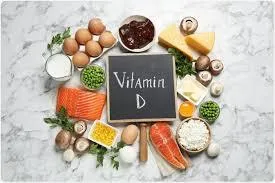Constantly Varied Nutrition Blog
It is our mission to educate and create an impact in the community by bringing nutrition to the forefront of health. Let us educate you about how to fuel your body optimally to balance your body's systems while keeping you active.

How vitamin D status shapes hormone synthesis, conjugation, and symptoms in perimenopause.
Vitamin D & Hormones: Why “Low D” can shift your whole endocrine picture and make hormone therapy less effective.

Hormone Therapy is less effective in a Vitamin D deficient environment. A recent look at Vitamin D status in Perimenopausal women showed an incredible 89% deficiency rate! This is both shocking and terrifying when the broad implications of what this means for your health get a close look. So let's talk through why Vitamin D is such an important topic of conversation for women in Perimenopause and why it shouldn't be ignored, especially if you're experiencing hormone imbalance symptoms.
Vitamin D & Your Hormones: why being low can hold everything back
Most people think of vitamin D as “the bone vitamin.” In reality, vitamin D behaves more like a hormone. Many hormone-sensitive tissues—ovaries, uterus, breast, liver, fat—carry vitamin-D receptors (VDR). When vitamin D is in a healthy range, its active form (calcitriol) helps switch on and off the genes your body uses to make and process hormones. When vitamin D is too low, those systems don’t run as smoothly. PMC
How vitamin D helps you make hormones (synthesis)
Inside the ovary, vitamin D signals to granulosa cells (the cells that support your eggs) and helps coordinate the steps of steroid hormone production. Lab and ex-vivo human studies show vitamin D can shift these cells toward healthier steroidogenic activity. In simpler terms: enough vitamin D = a friendlier setup for making estrogen and progesterone. PMC
One key “gatekeeper” here is aromatase (CYP19A1)—the enzyme that turns androgens into estrogens. Vitamin D can regulate aromatase in a tissue-specific way, which means your vitamin D status helps shape local estrogen levels in places like the ovary, breast, and fat tissue. Oxford Academic
We also see real-world signals: women with lower vitamin D tend to show lower estradiol across the menstrual cycle (and related shifts in the hormone milieu). That doesn’t prove cause-and-effect on its own, but it lines up with the biology above. PMC
How vitamin D helps you process/clear hormones (conjugation)
Making hormones is only half the story—your body also has to deactivate and clear them safely. One way it does that is by sulfation (adding a sulfate tag), which makes hormones more water-soluble for elimination. Vitamin D, through its receptor, can turn up the gene SULT2A1, a key sulfotransferase that sulfates hydroxysteroids like DHEA. If vitamin D is low, that “tag-and-clear” pathway may run sluggishly—think slower housekeeping for hormone byproducts. PubMed+1
So…what does this mean for symptoms and therapy?
When vitamin D is low, you can have two problems at once: less efficient hormone making and less efficient hormone processing. In perimenopause and menopause—when estrogen and progesterone are already in flux—this can make the whole system feel harder to balance.
Where does hormone therapy (HT) fit? HT provides hormones, but your body still relies on its own biology to distribute, use, and clear them. If vitamin D-dependent steps are underperforming, it’s reasonable to expect that you may not get the full potential benefit from HT until vitamin D deficiency is corrected. That’s why many clinicians view vitamin D repletion as part of setting the “metabolic stage” for any hormone plan.
Evidence check: We don’t yet have randomized trials proving that “HT is less effective in vitamin-D-deficient women.” What we do have is strong biologic plausibility (ovarian steroidogenesis, aromatase control, conjugation via SULT2A1) and observational data linking lower vitamin D to lower estradiol and more cycle irregularity—together supporting the practice of optimizing vitamin D alongside HT. Oxford Academic+2PubMed+2
Practical next steps
Test if there’s a reason. If symptoms, season, lifestyle, or skin tone put you at higher risk—or you’re starting HT—ask your clinician about checking 25(OH)D and correcting documented deficiency.
Fix the basics first. Smart daylight exposure, food sources (fatty fish, egg yolks, fortified options), and consistent protein and resistance training (these support steroid hormone building blocks and insulin sensitivity).
Supplement conservatively if you’re low. Pair vitamin D with cofactors like magnesium (activation) and consider vitamin K2 for calcium handling; re-test to confirm you’re back in range rather than chasing mega-doses.
Remember the whole picture. Gut health, sleep, and stress chemistry all play into how you make and clear hormones.
Selected research (plain-English takeaways)
Ovary & Synthesis: In human granulosa cells, vitamin D shifts gene programs tied to follicle development and steroid production—mechanistic support for better hormone “making” when D is adequate. PMC
Aromatase Control: Calcitriol regulates aromatase (CYP19A1) tissue-selectively, shaping local estrogen production. Oxford Academic
Conjugation/Clearance: VDR activation can up-regulate SULT2A1, a key enzyme that sulfates hormones like DHEA to aid safe clearance. PubMed+1
Real-world Hormones: Lower vitamin D status tracks with lower estradiol across the cycle in community samples of women. PMC
How I build this into care for my clients
Personally, I'm a Holistic Methods First kinda gal, so sunlight exposure, nervous system regulation, sleep, and whole food first. Then, we test when there’s a clinical reason. I like getting a pulse on this every 4-6 months as levels can change drastically in short time periods (like winter or periods of high acute stress) and correct true deficiency with conservative dosing of quality Vitamin D. I'm a hige fan of liposomal versions as they're more bioavailable. And last, but certainly not least, support cofactors for Vitamin D synthesis and utilization (magnesium for activation, vitamin K2 for calcium handling, melatonin for metabolism regulator).
Layer this with protein and high fiber-forward meals, resistance training, sleep, stress hygiene and more play and you've got the simple recipe for optimal hormonal health in Perimenopause.
The goal is not chasing mega-doses, it’s restoring a physiologic range so your own hormone machinery—and any therapy you choose—has a better environment to work in. I'd love to hear your thoughts on this. You can find me @Dana.Lynne.Black on Instagram. Shoot me a message any time!

